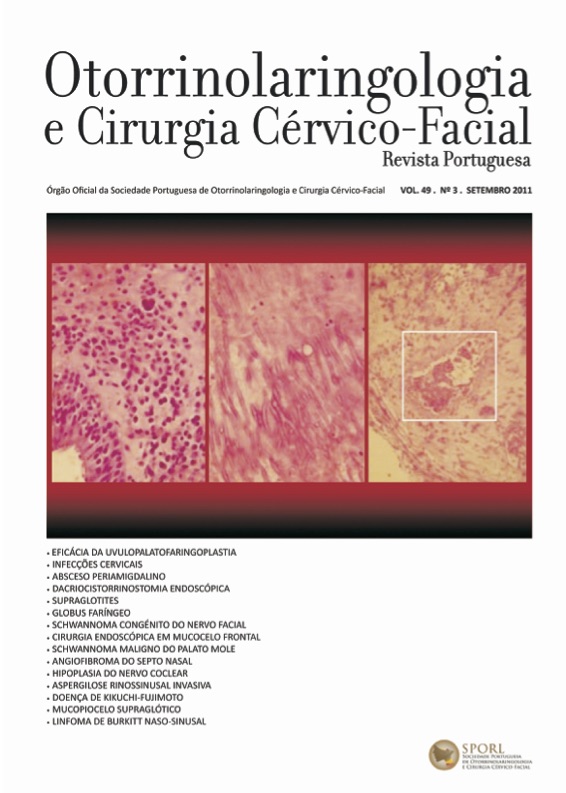Invasive nasal and paranasal aspergillosis
DOI:
https://doi.org/10.34631/sporl.183Keywords:
Aspergillosis, rhinosinusal, complicationsAbstract
Rhinosinusal aspergillosis is a rare clinical entity. However, particularly in immunocompromised patients, can present itself as a severe invasive form and can be potentially fatal. The identification of this pathology and its associated complications is not always easy. The disclosure of the different presentations helps the diagnosis.
The authors present the case of a patient with a fulminate invasive form of rhinosinusal aspergillosis, which highlights diagnostic difficulties and relevant therapeutic aspects.
Prompt diagnosis and treatment may prevent the high mortality associated with this condition. Orbital and intracranial complications are the most frequent and should be promptly identified and treated. The combination of medical and surgical treatment is a good therapeutic option.
Downloads
References
Ramadan H. Sinusitis Fungal. Emedicine; 2009. Consultado a 02 de Abril de 2010.
Coste A, Bretanhe S, Jankowski R. Mycoses rhinosinusiennes. Encycl Méd Chir Oto-rhino-laryngologie. Elsevier. 2003; 20-455-A-10: 6-11.
Patron V, Oreel S, Caire F, et al. Endonasal Trans-Ethmoidal Drainage of a Cerebral Abscess. Skull Base. 2010; 20 (5): 389-392.
Kasapoglu F, Coskun H, Ozmen OA, et al. Acute invasive fungal rhinosinusitis: evaluation of 26 patients treated with endonasal or open surgical procedures. Otolaryngol Head and Neck Surg. 2010; 143(5): 614-620.
Park AH, Muntz HR, Smith ME, et al. Pediatric invasive fungal rhinosinusitis in immunocompromised children with cancer. Otolaryngol Head Neck Surg. 2005; 133(3):411–416.
Finkelstein A, Contreras D , Pardo J, et al. Paranasal sinuses computed tomography in the initial evaluation of patients with suspected invasive fungal rhinosinusitis. European Archives of Oto-Rhino-Laryngology. 2011;268: 1157-1162.
Knipping S , Holzhausen HJ, Koesling S, et al. Invasive aspergillosis of the paranasal sinuses and the skull base. European Archives of Oto-Rhino-Laryngology. 2007; 264 (10): 1163-1169.
Souza ATCL, Soares YCMM, Valentim Filho J, Santos P C R, et al. Aspergioma de seio frontal com expansäo para a órbita: revisão. J Bras Med. 1995; 69(5/6): 124-31.
Mannning S. Fungal Sinusitis. Rhinology and Sinus Disease. A Problem-Oriented Aproach. 1998; 12: 99-104.
Dornbusch H J, Manzoni P, Roilides E, Walsh TJ, Groll AH. Invasive Fungal Infections in Children. Pediatr Infect Dis J. 2009; 28(8):734-737.
Herbrecht R, Denning D, Patterson T, et al. Voriconazole versus Anphotericin B for primary therapy of Invasive Aspergillosis. N Engl J Med. 2002; 347: 408-415.






